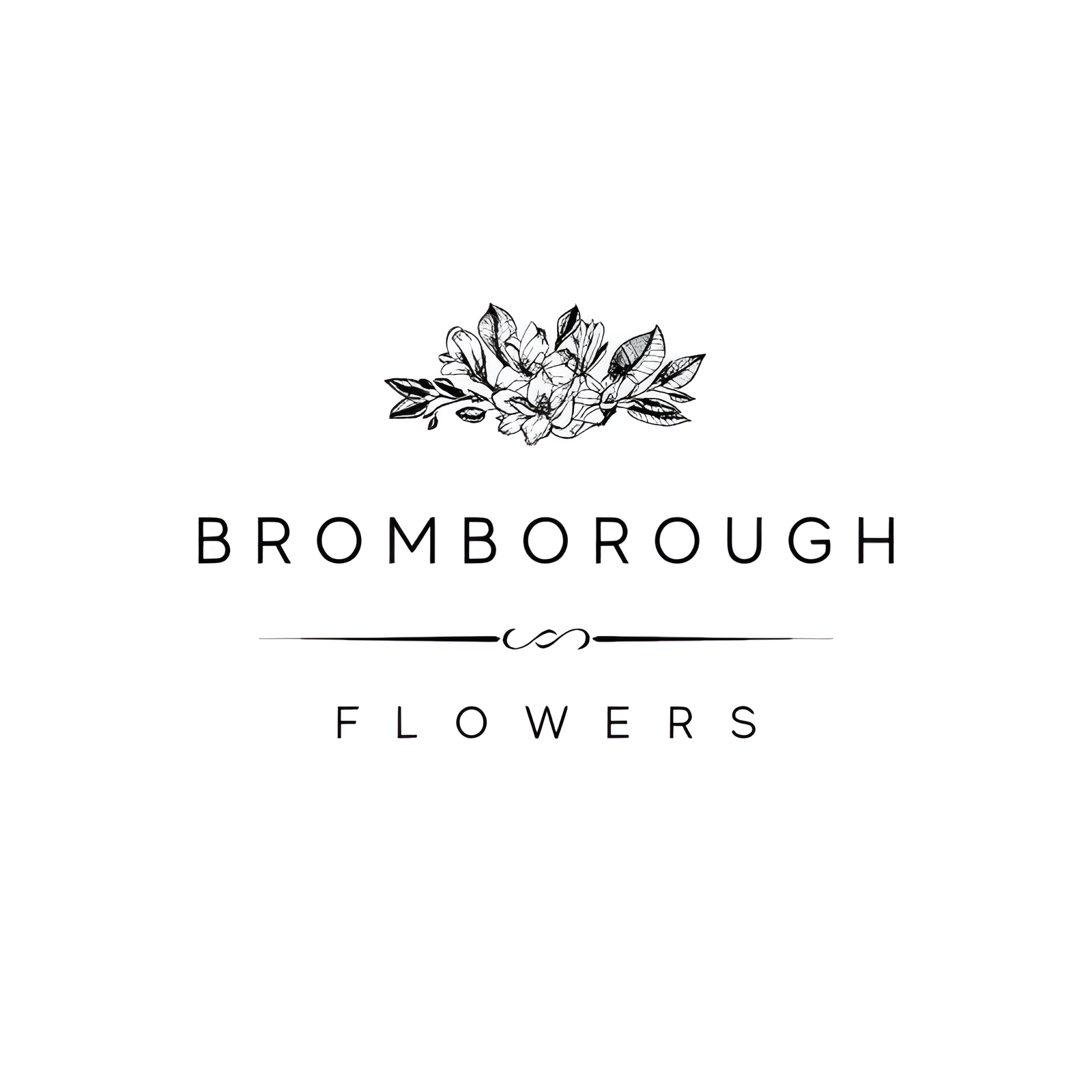In the world of wedding floristry, the anemone stands out as a flower of understated elegance and profound symbolism. Known for its soft, silky petals and striking dark centers, the anemone embodies hope, purity, and the promise of love. Its versatile color palette, ranging from classic whites to vivid purples and reds, allows it to complement various wedding themes seamlessly. As we explore the various aspects of this exquisite bloom, from its botanical roots to its cultural significance, you’ll find that the anemone offers much more than meets the eye.
Flower Overview
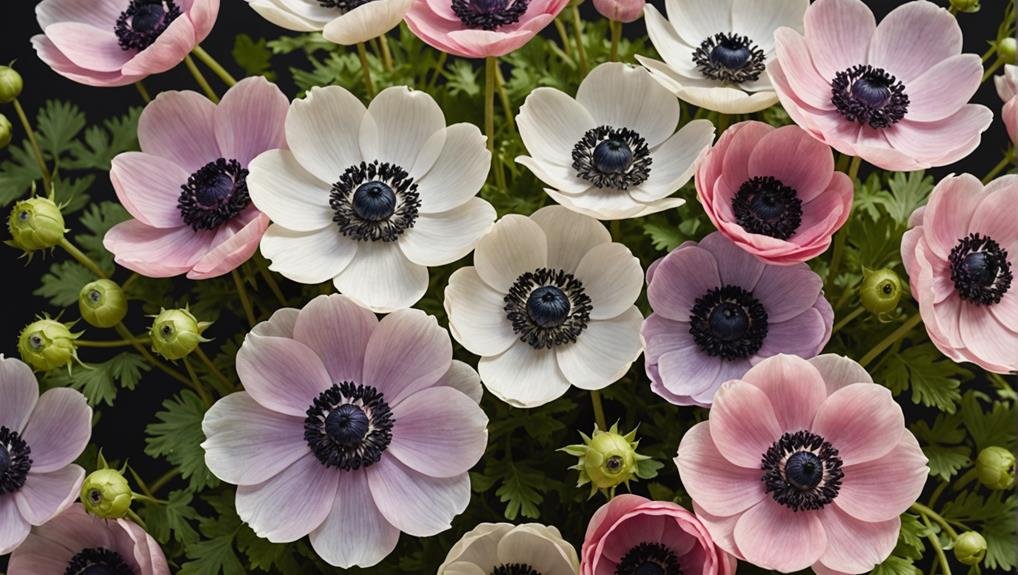
Anemones, members of the buttercup family Raununculaceae, are renowned for their delicate and airy appearance. Originating from the Greek word ‘anemos,’ meaning ‘wind,’ these flowers epitomize elegance and grace. Anemones showcase a diverse palette, spanning from vivid to soft hues, making them a versatile choice for various floral arrangements.
In the context of wedding floristry, anemones have gained significant popularity. Their unique aesthetic and vibrant colors provide a striking addition to any bouquet or centerpiece. Wholesale flower markets typically offer anemones in wraps of 50 stems, allowing florists ample material to craft exquisite arrangements. Their versatility and charm make them suitable for both modern and traditional wedding themes.
Anemones are particularly favored for their longevity in vases, lasting up to 7-9 days with proper care and conditioning. This durability ensures that wedding bouquets and centerpieces remain fresh and enchanting throughout the event.
When included in bridal bouquets, anemones contribute a touch of sophistication and natural beauty that enhances the overall visual appeal.
Physical Description
Characterized by their soft, silky petals and a prominent central disc, these flowers exhibit an enchanting, delicate beauty that enhances any floral arrangement. White anemones, with their stark contrast between the creamy white petals and the dark center, are particularly striking. This juxtaposition of light and dark makes them a favored choice for bridal bouquets, adding an element of sophistication and elegance to the occasion.
The petals of anemones are often described as delicate, with a texture that feels almost ethereal to the touch. This fragility is part of their charm, conveying a sense of grace and refinement. Each bloom typically features five to eight petals that encircle the central disc, which is densely packed with stamens. The dark center of the white anemone is especially spellbinding, drawing the eye and providing a focal point within the arrangement.
Anemones are relatively small, usually measuring between 2 to 4 inches in diameter. Despite their modest size, they have a remarkable ability to stand out. This makes them ideal for use in wedding floral arrangements, where their delicate aesthetic can be highlighted to its fullest potential.
Available Colour Varieties
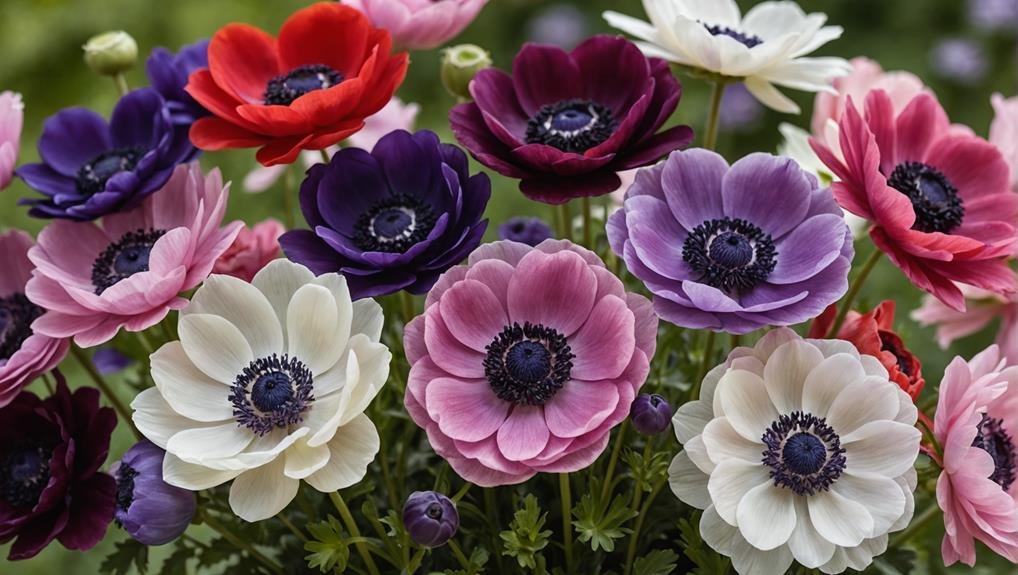
While the classic white anemone with its striking dark center remains a quintessential choice for wedding bouquets, these alluring flowers boast a diverse palette of available color varieties. The white anemones, often referred to as black-eyed anemones due to their prominent centers, are a timeless and elegant option. However, couples seeking to add a splash of color to their arrangements will find an array of enchanting hues to choose from.
Purple anemones offer a rich and regal touch, perfect for adding depth and sophistication to any floral display. The vibrant red and delicate pink varieties bring warmth and a sense of romance, ideal for creating a passionate and tender ambiance. Additionally, burgundy and blue anemones provide unique and enthralling alternatives for those wanting to make a bold statement.
Different color varieties can be artfully combined to craft exquisite and personalized wedding arrangements. To better visualize the spectrum of hues available, refer to the table below:
| Color Variety | Description |
|---|---|
| White Anemones | Classic, elegant with a striking dark center |
| Purple Anemones | Rich, regal, and sophisticated |
| Black-Eyed Anemones | Bold, striking contrast, timeless elegance |
This diverse range of color options guarantees that anemones can complement any wedding theme or décor, making them a versatile choice for any celebration.
Latin Name and Taxonomy
The anemone, scientifically known as Anemone coronaria, belongs to the buttercup family Ranunculaceae. This family, known for its diverse and vibrant members, includes other well-known plants such as Pasque flowers and Hepaticas. Anemone flowers are highly regarded for their striking appearance and are a popular choice in wedding arrangements due to their variety of bright and pastel colors.
Anemone coronaria, the specific species commonly used in floral designs, is distinguished by its delicate petals and central, dark-colored stamen that creates a dramatic contrast. This species’ taxonomic classification under the Ranunculaceae family places it among a lineage of plants known for their ornamental and horticultural value. The buttercup family itself is characterized by its herbaceous plants, many of which possess vibrant blooms and complex flower structures.
Wholesale anemones are typically sold in wraps of 50 stems, making them a convenient choice for florists and event planners. Their botanical name, Anemone coronaria, reflects their regal and crowned appearance, further establishing their status as a favored flower in elegant and sophisticated floral arrangements.
Understanding the taxonomy and scientific classification of anemone flowers helps in appreciating their unique qualities and their esteemed position in floral art.
Geographical Origins
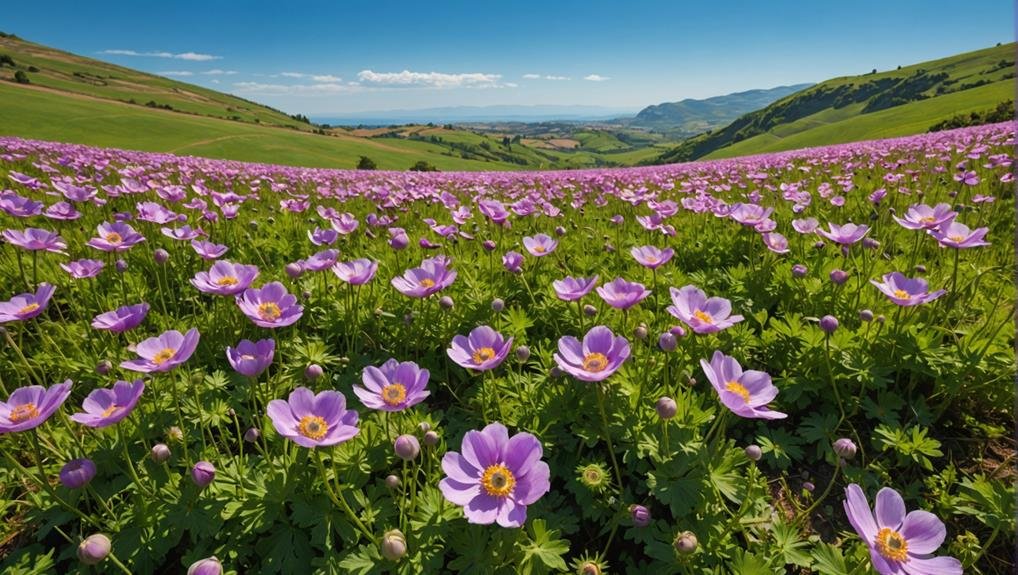
Rooted in the rich history of the Mediterranean region, anemones have long been celebrated for their enchanting beauty and mythological significance. Anemones are delicate flowers that thrive in temperate climates, making them a versatile choice for floral arrangements worldwide. The geographical origins of anemones can be traced to various regions, where they have been cultivated to meet global demand.
Anemones come from diverse locations, each contributing to their availability and vibrant variety. Here are some key regions where anemones are grown:
- Mediterranean Region: The native land of anemones, offering ideal growing conditions and a rich cultural heritage.
- Europe: Countries like Italy and France are known for producing high-quality anemones, prized for their vibrant colors.
- North America: The United States has become a significant producer, particularly in states with temperate climates.
- Asia: Japan and China also cultivate anemones, contributing to the global floral market.
For DIY brides, understanding the geographical origins of anemones can be essential in selecting the right variety for their wedding. Different regions offer unique colors and species, ensuring a personalized touch to floral designs. Whether sourced locally or internationally, anemones bring a timeless elegance to any wedding.
Season Availability
Anemones, with their striking blossoms, are mainly available from late autumn through early spring, aligning perfectly with winter wedding aesthetics. This season availability guarantees that anemones thrive in cooler temperatures, making them an ideal choice for weddings during these months. The peak season for anemones typically spans from November through April, during which they are most vibrant and plentiful.
While the general season availability of anemones extends from late autumn to early spring, it’s worth mentioning that specific varieties may have different peak seasons. For example, spring-blooming anemones are more commonly found from March to May, adding a fresh touch to early spring weddings.
Conversely, fall varieties are abundant from September to November, offering rich, deep hues that complement autumnal themes.
When planning a wedding, considering the seasonality of anemones is essential for ensuring their availability in your floral arrangements. By aligning your wedding date with the peak season of anemones, you can make the most of their natural beauty and availability. This thoughtful planning can enhance the overall aesthetic of your wedding, ensuring that the floral arrangements are both stunning and seasonally appropriate.
Growing Conditions
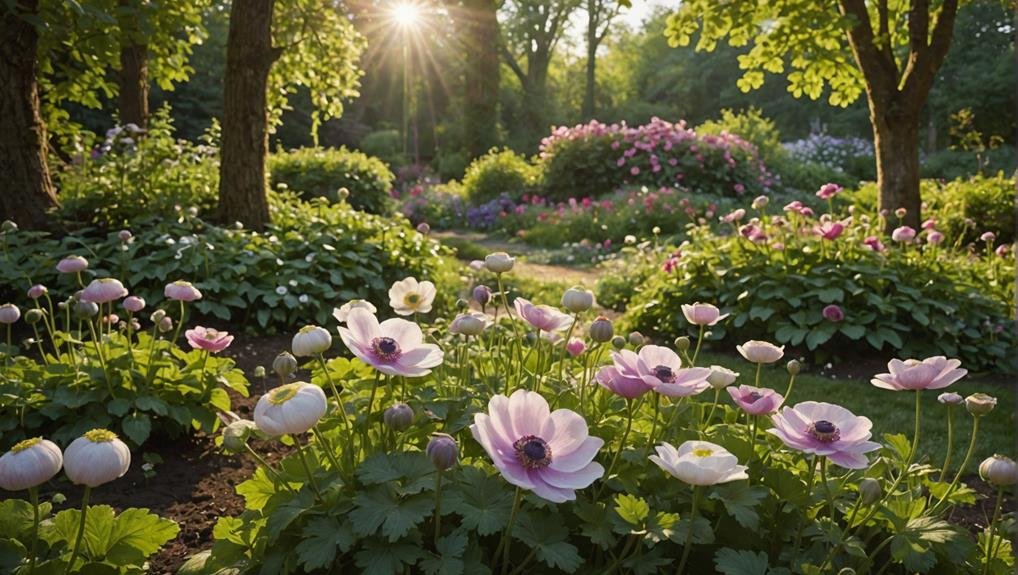
To flourish, anemones need well-drained soil and exposure to full sun or partial shade. These flowers bloom under specific growing conditions that cater to their unique needs. Making sure the soil is well-drained is vital, as anemones are prone to root rot if waterlogged. They prefer cooler temperatures and can withstand light frosts, making them versatile across various climates.
Regular watering is crucial, especially during dry spells, to maintain ideal moisture levels without over-saturating the soil. Anemones can be propagated from corms or seeds, but corms are often the preferred method due to their reliability and faster growth.
To further enhance their growing environment, consider the following tips:
- Proper spacing: Ensure sufficient space between plants to promote good air circulation and prevent disease.
- Sunlight exposure: While anemones thrive in full sun, partial shade can also be advantageous, especially in hotter climates.
- Soil amendments: If the soil is heavy or clay-based, incorporate organic matter to enhance drainage.
- Mulching: Apply a light mulch to retain soil moisture and suppress weeds, but avoid covering the corms directly.
Cultural Significance
Anemone flowers hold deep cultural significance in various traditions, often symbolizing themes such as hope, purity, and love. In Greek mythology, they are linked to the tears of Aphrodite, wept for her beloved Adonis, imbuing them with a poignant sense of love and loss. This mythological background adds a layer of romantic touch to these blooms, making them a compelling choice for significant life events.
In Victorian symbolism, anemones represent anticipation and excitement for the future, making them ideal for wedding bouquets. Their distinctive appearance, characterized by a dark center surrounded by delicate petals, further enhances their appeal. This unique structure not only makes anemones stand out in floral arrangements but also conveys a message of elegance and sophistication.
The cultural significance of anemones extends beyond mythology and symbolism. They are often associated with the promise of love and purity in various cultures, reinforcing their suitability for weddings. As an elegant flower, anemones capture the essence of romance and commitment, offering a meaningful addition to any bridal bouquet. Their bold yet delicate beauty ensures they leave a lasting impression, elevating the aesthetic of wedding ceremonies.
Typical Use in Weddings
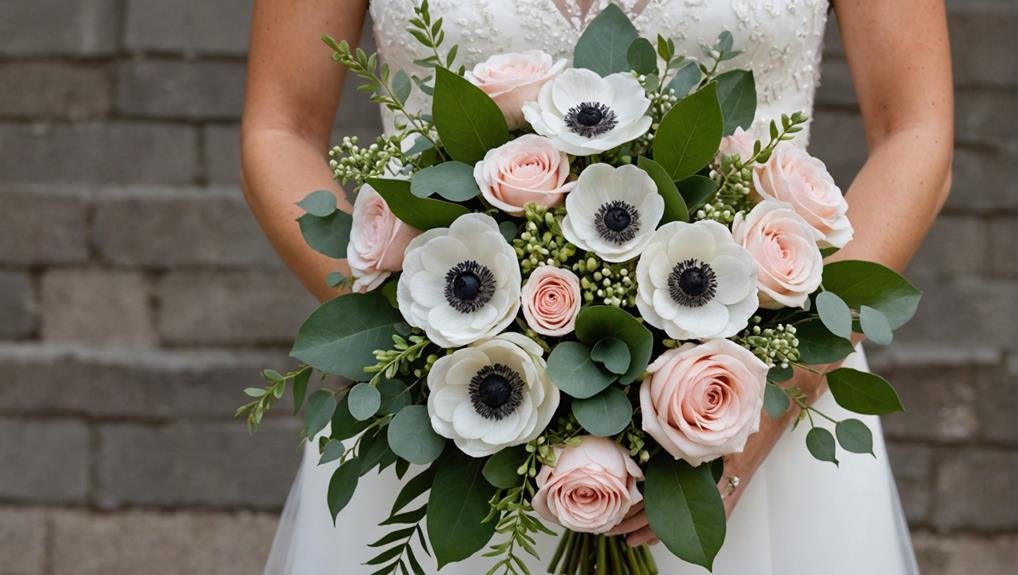
Widely cherished for their striking appearance, anemone flowers are frequently included in bridal bouquets, bridesmaid arrangements, and wedding centerpieces. Their bold colors and distinctive focal point make them ideal for creating captivating floral arrangements that perfectly complement any wedding theme. Symbolizing hope, purity, and the promise of love, anemones add a unique and romantic touch to wedding decor.
Anemone flowers are particularly popular in DIY wedding flower projects, as their versatile nature allows for creative and elegant designs. Whether paired with other blooms or standing alone, anemones offer endless possibilities for stunning wedding floral arrangements.
- Bridal Bouquets: Anemones serve as a beautiful focal point, adding sophistication and elegance.
- Bridesmaid Bouquets: These blooms create a cohesive and harmonious look, enhancing the overall wedding theme.
- Centerpieces: Anemones make striking centerpieces, drawing attention and adding a touch of romance to reception tables.
- Boutonnieres and Corsages: Their bold appearance makes them perfect for adding a unique touch to the groom’s and groomsmen’s attire.
Incorporating anemones into your wedding guarantees a memorable and visually enchanting event. Their versatile and bold nature makes them a favorite choice for many couples seeking to create a distinctive and elegant wedding atmosphere.
Alternative Flower Types
When considering alternative flower types for weddings, roses, peonies, dahlias, and ranunculus each offer unique aesthetic qualities and symbolic meanings that can enhance various wedding themes.
Roses are a timeless choice, symbolizing love and romance. Their classic beauty and wide range of colors make them versatile for any wedding style, from traditional to contemporary.
Peonies, admired for their lush, full blooms, represent prosperity and good fortune. Their soft, ruffled petals add a touch of elegance and luxury to bouquets and centerpieces, making them a popular choice for spring and early summer weddings.
Dahlias, known for their bold and vibrant hues, come in a variety of sizes and shapes. They are perfect for adding a dramatic flair to floral arrangements, making them ideal for couples looking to make a statement with their wedding decor.
Ranunculus flowers, with their delicate layers of petals, create a soft and romantic look. Their intricate structure and diverse color palette make them a charming addition to any bouquet, particularly for those seeking a whimsical and enchanting atmosphere.
